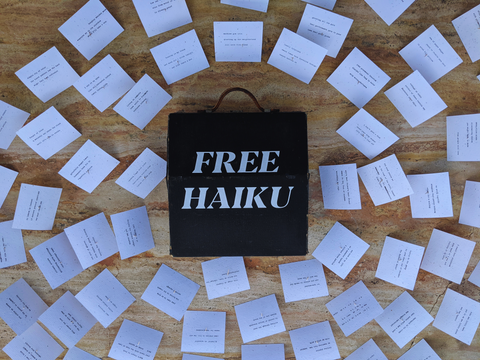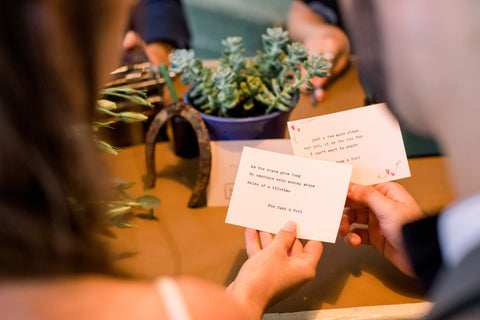When our Haikuists sit down at our typewriter in various events settings to write personalized haiku on the spot, we’re often met with questions about haiku. Here we will offer an overview of an answer to the question:
Where does Haiku come from?
Haiku is a traditional Japanese poetic form originating in the seventeenth century, having roots as far back as the end of the traditional Japanese era, the Heian period (~ 700 - ~ 1100 CE). This period in Japanese history is regarded by many as Japan’s Golden Age for the cultural flourishing which took place among the wealthy and politically favored. Historian George Sansom shares: "The most striking feature of the aristocratic society of the Heian capital was its aesthetic quality. It is true that it was a society composed of a small number of specially favored people, but it is nonetheless remarkable that, even in its emptiest follies, it was moved by considerations of refinement and governed by a rule of taste."

Photo by Jason Rost on Unsplash
Literature popular among the Heian-kyo elite often adhered to complex formal constraints, mirroring the Heian-kyo elite’s aesthetic preferences for tight, inflexible structure--for their allegiance to unyielding expectations. In fact, knowledge of and appreciation for the literary arts was a social requirement among the wealthy aristocrats and imperial court members of Heian-kyo; people in these circles were expected to be able to recognize and recite Japanese and Chinese poetry.
Haiku evolved out of a longer poetry form called renga popular among elites during this period. Renga, meaning “linked verse,” was actually a literary game with complex rules played between two or more people.
How do I play Renga?
- The hokku, or “opening verse,” uses the same unrhymed three-line 5-7-5 syllabic structure we recognize in haiku today. Typically the guest of honor opened the renga in a celebratory tone, traditionally making reference to tōki, “this season,” and tōza, “this session,” or the gathering itself.
- The host continued the conversation in verse, following the hokku with the waki, or “flank,” a 7-7 syllable count couplet traditionally offered in a self-deprecating tone. In Japanese culture, this was intended to indicate modesty, signaling a polite response to the guest of honor’s praises.
- Continue alternating between players as appropriate, switching back and forth between the 5-7-5 tercet and 7-7 couplet form until the renga completes, typically for fifty turns or one hundred verses.
How did Haiku evolve out of Renga?
After the Heian period, renga became popular outside of the imperial court, where the imperial court’s preferences for rigidity did not apply, and rule-bending and experimentation were welcome. Haiku master Bashō and his friends were among these early experimenters. Together they played their own invented version of renga, writing haikai, meaning “humorous,” in order to distinguish their game from the traditional court version. Many of the renga rules became obsolete in this setting, however, some, such as the praising tone and seasonal references, or tōki, maintained relevance. During the end of the seventeenth century, writing hokku independently of renga or haikai became more common.

Photo by Alessia White on Unsplash
The terms hokku, the opening verse of imperial renga, and haikai, the humorous version, were combined by Shiki Masoaka to rename the current version, about three hundred years after Basho’s lifetime. Haiku was introduced to the west in the nineteenth century by Hendrik Doeff, a Dutchman trader who worked in Nagasaki, Japan. In the centuries following, haiku has been written by well-known poets in many languages across the world, such as Amy Lowell, Jack Kerouac, and Octavio Paz.
Written by Bianca Glinskas
_________________________________________________________________
Works Referenced + Further Reading
204e0cba1b0730ee27408fa8fa376329.pdf (thehaikufoundation.org)
What are Haiku, Senryu and Tanka? – Akita International Haiku Network (akitahaiku.com)
Read a Sampler of traditional Japanese haiku gathered by The Haiku Foundation.
Haiku and Its Technique - a column by Don Baird - All Poetry
Haiku vs. Senryū Poems: What's the Difference? - Japan Vault
Go-Shichi-Go: How Japanese and English Syllables Differ - Graceguts
Kireji – Cutting Words – Haiku of the Forest (wordpress.com)
A Brief History of Haiku : Literary Kicks (litkicks.com)
Haiku: The Evolution of a Strict Poetic Game ‹ Literary Hub (lithub.com)
Eras of History: The Heian Period - YouTube
George Sansom, A History of Japan to 1334 (Tokyo: Charles E. Tuttle Company, 1963, 1974), p. 178.



